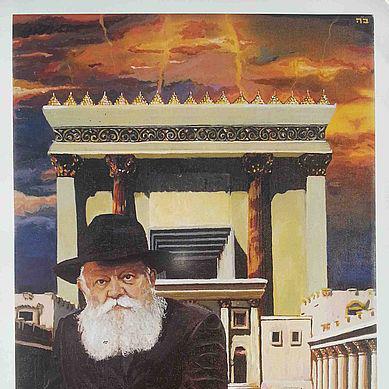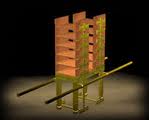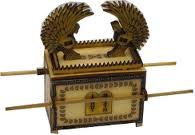The Temple rules

The Three weeks (three weeks between the Seventeenth of Tammuz to Tisha B'Av) practices learn the Laws of the Temple, engaged in building a temple and the vessels. Study of laws considered the selection of construction of the temple really. So precisely at a time when mourning the destruction of the Temple learn about the Temple and thus bring closer the building of speedily, Amen!!
There is a Torah commandment to build the Temple as it is written: "and they did a temple and I will dwell among them." All the children of Israel have a building of the Temple, except children, because they study the Torah and Torah study is more important than building the Temple.
At first, Moses built the Tabernacle with the children of Israel wandered in the desert. When they came to Israel the Tabernacle was in several places: Gilgal, Shiloh, Nov and Gibeon. Then, the Temple was determined in Jerusalem on Mount Moriah. Since the building of the Temple in Jerusalem was not allowed to build a temple elsewhere.
The First Temple, King Solomon built, the son of King David. First Temple existed for 410 years, until Nebuchadnezzar came and conquered Jerusalem and burned the Temple on Tisha B'Av. He carried into captivity the children of Israel to Babylonia, and known "Babylonian Exile".
The Second Temple built by Ezra and Nehemiah, when the children of Israel returned to Israel after the Babylonian exile, 70 years after the First Temple was destroyed. Second Temple existed for 420 years until the Romans came, led by General Titus besieged Jerusalem. And on the ninth of Av raised the temple on fire and destroyed it. All Jews, they took them captive to Rome.
Third Temple came down from heaven soon coming of the messiah. The prophet Ezekiel foretold in prophecy about the shape of the Third Temple.
The temple's parts

Parts of the temple are holy (Kodesh), and the Holy of Holiness (Kodesh Hakodashim). Before the room called "holy" There is a room called a hall (Ulam). As the Tabernacle was a large courtyard surrounding the tabernacle, so around the Hall was a large courtyard called "Azarah".
The courtyard has been divided into the three sections: women's section, Israel's section, and the section of priests (Cohen).
Holy of Holiness - the holiest place. It is forbidden to anyone to come in; except the High Priest on Yom Kippur.
When it came to make repairs in the temple by putting the employee in the box and he was looking only for what he fixes. To he will not see the Holy of Holiness.
In the "Holy" had three vessels: the Menorah, table of the bread and the golden altar. The golden altar also called incense altar, which must burn the incense twice a day, while cleaning and lighting the candles, in the morning and evening.
In the priests section, before the hall, stood the sacrificial altar where sacrifices were made. There was also a sink, where the priests washed their hands and feet whenever they started to work in the temple.
There are commands to build the Temple finest materials to beautify the Temple, as the ability of the people of Israel. If you cannot, build the Temple of simple materials, but when people of Israel have more money to donate for the temple to glorify it, and even to coating all the Temple with gold.
Build the temple only with stones or bricks. You cannot cut the stones in the Temple Mount, but outside of the temple, and bring the stones when cut and arranged into the temple. The stones of the altar must not cut at all and building it from whole stones. Iron touched stone, improper construction of the altar. But if it needed to cut the stones of the altar, cut them with "emery worm" in the Temple. Emery Worm is special as she walks she cut stones.
The Temple's Vessels
The Menorah, table and golden altar, and all the tools that belong to them, must be only from metal and not from wood or stone. If the people are poor; build base metal, and if they get rich, do the vessels again from gold.
On the Copper altar sacrificed the sacrifices. The altar was in the priest's section, where Adam was created, where Noah sacrificed sacrifice to G-d when he came out from the ark, which was the sacrifice of Isaac.
When they built the Second Temple, Three Prophets came with the children of Israel from the Babylonian exile: one predicted them to place the altar, and other predicted the size and shape, and the third predicted the sacrifice on the altar that all sacrifices, even though the Temple was not built.
The Golden Altar
Golden altar was all gold coated. Four corners of the top of the altar were hollow horns, between the horns; around the edge of the top of the altar is the gold wreath. On the golden altar burn the incense twice a day.
The Menorah

Menorah was seven branches; a middle branch and sis from the two sides, three branches from each side. The candles of the six branches were facing to the middle branch of the menorah. Menorah was several types of decorations: cups, knobs, and flowers. Front of the Menorah had three steps on which the priest came to clean and light the candles. In the evening was the priest lights the Menorah and in the morning cleaning it. Every night the priest put the same amount of oil in the Menorah, and this quantity could always, even in the short summer nights and the long winter nights.
When someone would enter the Hall of the Temple, saw all seven branches of Menorah, how? The Menorah was on the left, width direction of the Temple, when all branches are faced to the middle candle, and the middle candle bowing to the Holy of Holiness.
Table of the bread

On the table of showbread laid out the bread every Saturday. The bread remains on the table for a week, until next Saturday, and it remains freshly like it baked now. On top of the table were like bread shelves in two rows, a total had 12 loaves of bread. There were Special bowls that baked the bread to make it uniformly. Before bringing the bread to the table, the priests put it on a marble table, and after they took it and put the bread on gold table, that "raise holy and not lowering" (is not lowering holy bread from gold table, to a simple table.
The sink and sink's pedestal
There were 12 taps in the sink so that the priests could wash their hands and feet all at once without stopping. Next of the sink was a drum full of water; the water in the sink came from it, so always have water ready for the priests.
Pact's cupboard and the cherubim

In Holy of Holiness was a stone called "foundation stone" (which founded the world). On this stone placed the Pact's cupboard, which were the tables. Front of the wardrobe placed the "vial of manna", is a vial filled with some "manna" that Children of Israel eat in the desert, and blossomed Aaron's staff during the dispute of Korach and his congregation. Why put up the manna in there? is to the people of Israel remember their job in the world is learning Torah, as it was in the desert, and G-d shall provide livelihood to the Jews, like he provide them manna in the desert.
Before destruction of the temple King Yoshiyahu ordered to hide the Pact's cupboard in the hidden deep tunnel prepared by King Solomon when he built the temple. Pact's cupboard hidden in there and the coming of the Messiah is revealed again, and will be the Third Temple.
The holy of holiness was 10 meters, from west to east. Wide - from the north and the south was 10 meters. Pact's cupboard stood in the middle of the room. Pact's cupboard length was 1.25 meters. When measuring the southern wall to the Pact they found five meters. When measured on the north wall to the Pact found also 5 meters. When they measured the Pact alone was 1.25 meters long. When they measured north-south wall was 10 meters. Consequently Pact miracle did not take the volume, and stood the Holy of Holiness was for "avoiding impossible" (spiritual materialism can feel with hands).
Must act in the temple with respect and awe; go quietly, speak and act in fear, and keep in mind the Divine Presence rests in the Temple. Do not enter with road dust and shoes. Do not turn your back on the temple, and not sit in the temple and in the yard, except Kings David's descendants.